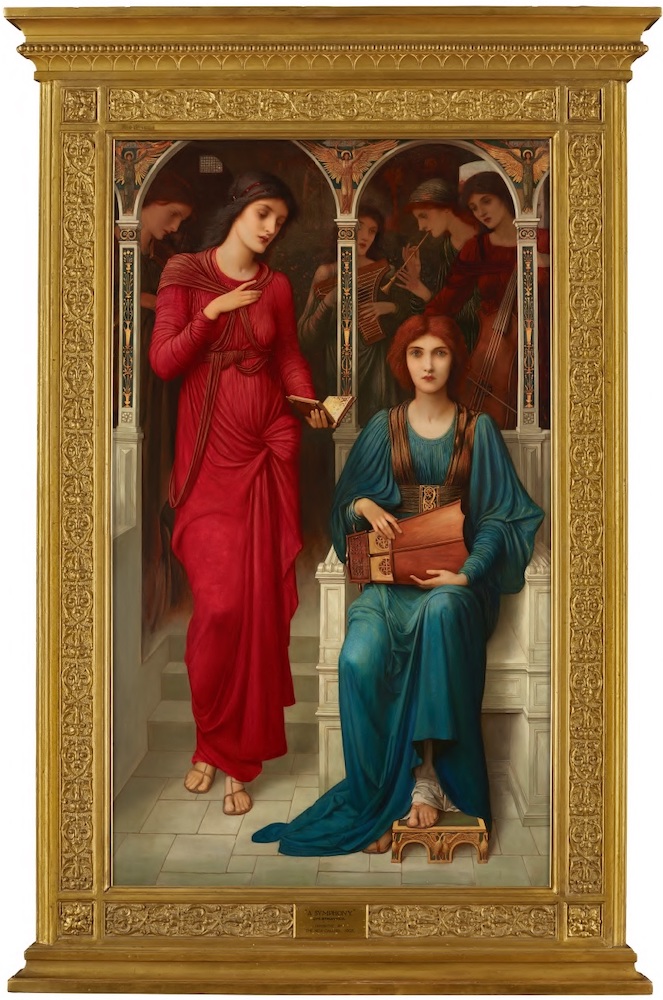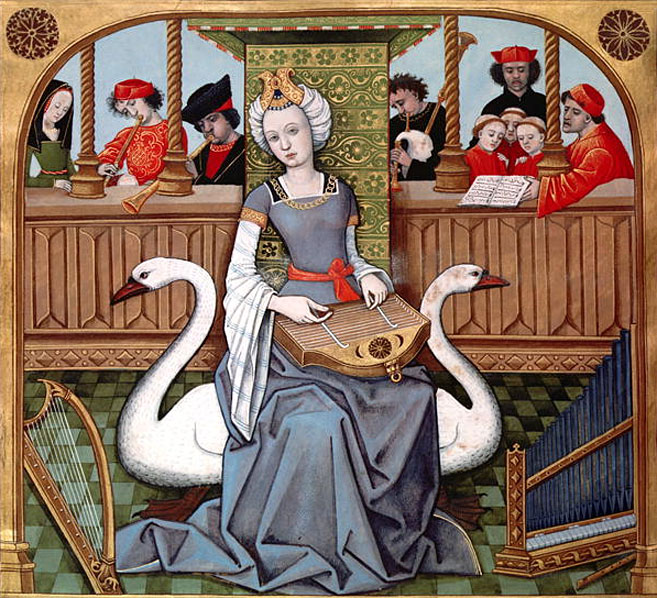
A Symphony by J.M. Strudwick. [Click on all the images on this page to enlarge them, and usually for more information about them.]
A Symphony was exhibited at the Sixteenth Summer Exhibition of the New Gallery in 1903, but in spirit, it belongs to another time. Forty years earlier, Whistler used the word "symphony" to describe a symphony of colour, yet Strudwick here uses the term more literally. The scene adheres to the aesthetic principle of a non-narrative subject, but the treatment of the composition owes more to artists of the Quattrocentro. The two foreground figures provide a contrast to each other - one seated, one standing. One dressed in red, one in blue. One holding a book of verse, the other a musical instrument. And one is engaged in the rapture of the words and music, whilst the other is looking intensely at the viewer.
The direct gaze of the seated figure may have been inspired by Burne-Jones's King Cophetua and the Beggar Maid another painting that is full of contrasts. As in Burne-Jones's painting, Strudwick has added a group of secondary figures within a raised gallery at the rear of the composition. These include musicians playing a zither, a pipe and a viol. Behind them is a screen decorated with saintly figures, and beyond this a small grated opening to the left and an arched window to the right – again two features in stark contrast to each other. It is almost as if the two sides of the composition are like contrasting movements within a symphony. As with every one of Strudwick's mature works, the treatment of the drapery is exquisite and the painting of the architectural details is breathtaking. Of particular note are the foot rest decorated with herons spreading their wings, and the arched columns surmounted by angels with their wings outspread. These are reminiscent of the mosaic angels designed by Sir William Blake Richmond for the choir pendentives in St Paul's Cathedral.
Strudwick also looks to much earlier sources for inspiration, the architectural details within his work regularly echoing those of Early Renaissance artists like Pinturicchio, Domenico Ghirlandaio and Giovanni Bellini. Strudwick's paintings differ, however, in that Early Renaissance compositions tend to focus either upon a saintly figure, or upon some religious or mythological narrative. A Symphony places two women at the front of the composition, where one might expect a Madonna to be placed with angels behind. One possible source that doesn't follow this convention is an illustration of an Allegory of Music within a manuscript illuminated by Robinet Testard in the Bibliothèque Nationale de France.

Allegory of Music, Robinet Testard (with thanks to the Bibliothèque Nationale de France).
Here the foreground figure plays a zither, whilst seated upon two swans. Musicians and singers are assembled behind an arched screen in a minstrel's gallery, similar to the space at the rear of Strudwick's painting. Other possible sources for Strudwick's composition are Benvenuto di Giovanni's Marriage of the Virgin Mary, in which musicians perform within an arched space, and Filippo Lippi's triptych depicting the Coronation of the Virgin, in which instrument-playing angels are tiered behind Dominican saints and a Benedictine monk.
Music is a continuing theme throughout Strudwick's art and A Symphony is part of a series of scenes with a similar underlying subject, each rendered with the same attention to detail. In his 1906 painting of When Apples Were Golden and Songs Were Sweet but Summer Had Passed Away (Manchester Art Gallery), the scene is set outdoors, but the figures are placed in a similar position to those within A Symphony, painted a few years earlier. Although the artist employs his usual practice of placing his principal figures within the confines of a distinct foreground, the choice of setting couldn't be more different. His rendering of the trees and landscape beyond is as detailed as his decorative interiors, and once again, one figure plays an instrument, whilst the other reads from an open book.




A selection of Strudwick's paintings with musical themes. From left to right: (a) St Cecilia, 1882. (b) St Cecilia, 1896. (c) Evensong [St Cecilia], 1897. (d) When Apples Were Golden and Songs Were Sweet but Summer Had Passed Away (1906).
The concept of capturing the essence of a musical performance within the medium of paint has been a challenge that was taken up by artists of the Italian Renaissance and one that continued right through to Strudwick and his Pre-Raphaelite precursors. It is little surprise, then, that in more recent years A Symphony has been sourced as an illustration within a book about the imagery of music, and has even featured as the cover for a book of sheet music for organ.
To date only two studies have been identified for figures within A Symphony. The first is a head study for the left-hand female figure at the rear of the composition. The drawing was offered for sale by Freeman's Auctions, Philadelphia (18 June 2013, lot 94) as a study by Burne-Jones. Drawings by Strudwick are frequently misattributed to Burne-Jones. Almost all of the known studies by Strudwick are in pencil, and are subtly different in handling from studies by Burne-Jones. A second pencil study by Strudwick shows a woman full face. Because of this, it was identified as a study for the seated figure within A Symphony. The model's hairstyle and facial features, however, do not accord with those of the seated woman within the painting, so it seems unlikely that the two are related. The drawing was most recently sold by Lyon & Turnbull Auctioneers (11 November 2015, lot 222). One would expect Strudwick to have made more studies for such a complex and detailed composition. In the catalogue for the 1989 Burne-Jones, the Pre-Raphaelites and their Century exhibition, Hilary Morgan helpfully explains: "In the present painting, by drawing directly onto the canvas and then building up a series of thin glowing glazes in the Pre-Raphaelite manner, Strudwick creates both a richness and delicacy."
Related Material
Bibliography
Catalogue entry for A Symphony. Martin Beisly Fine Art, London.
Kolsteren, Steven. "The Pre-Raphaelite Art of John Melhuish Strudwick (1849-1937)." The Journal of Pre-Raphaelite and Aesthetic Studies I:2 (Fall 1988): 12, no. 32.
Morgan, Hilary. Burne-Jones, the Pre-Raphaelites and their Century. Peter Nahum, London, 1989: 159.
Created 3 October 2025